| Listing 1 - 10 of 16 | << page >> |
Sort by
|
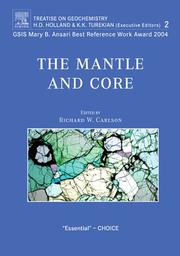
ISBN: 1281118753 9786611118754 0080549012 9780080549019 0080448488 9780080448480 9781281118752 6611118756 Year: 2005 Publisher: Amsterdam Boston Elsevier
Abstract | Keywords | Export | Availability | Bookmark
 Loading...
Loading...Choose an application
- Reference Manager
- EndNote
- RefWorks (Direct export to RefWorks)
Though largely inaccessible, the geochemistry of Earth's mantle and core can be examined through a wide variety of approaches. Volume 2 focuses first on ""remote"" sensing using evidence from cosmochemical, seismic, petrologic and geochemical approaches. Mantle composition is then examined in detail through descriptions of mantle samples brought to Earth's surface through tectonic, volcanic, and volatile-outgassing processes. The volume concludes with examination of processes that modify the composition of the mantle and core including an early magma ocean, partial melting, element partitioning
Geochemistry. --- Chemical composition of the earth --- Chemical geology --- Geological chemistry --- Geology, Chemical --- Chemistry --- Earth sciences --- Earth --- Core. --- Mantle. --- Earth (Planet)
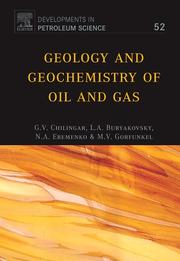
ISBN: 1280641673 9786610641673 0080461212 0444520538 9780080461212 9780444520531 Year: 2005 Publisher: Amsterdam ; London : Elsevier,
Abstract | Keywords | Export | Availability | Bookmark
 Loading...
Loading...Choose an application
- Reference Manager
- EndNote
- RefWorks (Direct export to RefWorks)
This book discusses the progress that is being made through innovations in instrumental measurements of geologic and geochemical systems and their study using modern mathematical modeling. It covers the systems approach to understanding sedimentary rocks and their role in evolution and containment of subsurface fluids. Fundamental aspects of petroleum geology and geochemistry, generation, migration, accumulation, evaluation and production of hydrocarbons are discussed with worldwide examples. Various physical and chemical properties of subsurface waters, crude oils and natural gases
Petroleum --- Natural gas --- Geochemistry. --- Geology. --- Chemical composition of the earth --- Chemical geology --- Geological chemistry --- Geology, Chemical --- Chemistry --- Earth sciences --- Geology --- Petroleum geology
Periodical

ISSN: 18115217 Year: 2005 Publisher: Richmond Hill, ON : Mineralogical Society of America,
Abstract | Keywords | Export | Availability | Bookmark
 Loading...
Loading...Choose an application
- Reference Manager
- EndNote
- RefWorks (Direct export to RefWorks)
Mineralogy --- Geochemistry --- Petrology --- Minéralogie --- Geochemistry. --- Mineralogy. --- Petrology. --- Minéralogie. --- Géochimie. --- Pétrologie. --- Lithology --- Petrography --- Chemical composition of the earth --- Chemical geology --- Geological chemistry --- Geology, Chemical --- Physical geology --- Rocks --- Crystallography --- Minerals --- Chemistry --- Earth sciences --- Géochimie --- Pétrologie

ISBN: 1280618590 9786610618590 1615831347 0387256563 0387236082 1461498562 Year: 2005 Publisher: New York : Springer,
Abstract | Keywords | Export | Availability | Bookmark
 Loading...
Loading...Choose an application
- Reference Manager
- EndNote
- RefWorks (Direct export to RefWorks)
Recent advances have pushed the limits of lithography firmly into the sub-100 nm domain, with smallest feature sizes around 10 nm. However, compared to living organisms, devices fabricated using nanolithography are not nearly as complex, as they are essentially 2D and contain only a limited number of chemical elements. For centuries, Nature has been a major inspiration for science. First of all to learn how Life functions at cellular level, but increasingly, as a blueprint for designing non-natural devices where the building blocks and their assembly are inspired by biological examples. The key tool in translating these examples into the domain of engineering, has been self-assembly or self-organization. This book gathers a spectrum researchers who have not only furthered our knowledge of self-assembly using small molecules, polymers and colloidal particles as building blocks, but who have also shown it to be a practical tool in the assembly of an astonishing variety of devices, ranging from molecular electronics to biosensors.
Nanotechnology. --- Nanostructures. --- Molecular technology --- Nanoscale technology --- High technology --- Nanoscience --- Physics --- Chemistry, inorganic. --- Chemistry, Physical organic. --- Geochemistry. --- Inorganic Chemistry. --- Physical Chemistry. --- Chemical composition of the earth --- Chemical geology --- Geological chemistry --- Geology, Chemical --- Chemistry --- Earth sciences --- Chemistry, Physical organic --- Chemistry, Organic --- Chemistry, Physical and theoretical --- Inorganic chemistry --- Inorganic compounds --- Inorganic chemistry. --- Physical chemistry. --- Chemistry, Theoretical --- Physical chemistry --- Theoretical chemistry
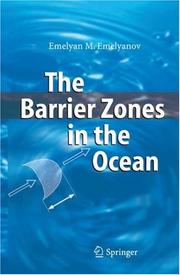
ISBN: 1281250791 9786611250799 354026230X 3540253912 3642064795 Year: 2005 Publisher: Berlin ; New York : Springer,
Abstract | Keywords | Export | Availability | Bookmark
 Loading...
Loading...Choose an application
- Reference Manager
- EndNote
- RefWorks (Direct export to RefWorks)
Geochemical barrier zones play an important role in determining various physical systems and characteristics of the oceans, e.g. hydrodynamics, salinity, temperature and light. In this book, each of the 40 barrier zones covered are illustrated and defined by physical-chemical parameters. Among the topics discussed are the processes of inflow, transformation and precipitation of the sedimentary layer of the open oceans and more restricted areas such as the Baltic, Black and Mediterranean Seas. This well-illustrated book may serve as the basis for courses such as "Marine Geochemistry" or "Ocean Usage" and can be useful to researchers in the fields of geology, geography, marine chemistry, geoecology and hydrochemistry.
Chemical oceanography. --- Metallogeny. --- Sedimentation and deposition. --- Deposition and sedimentation --- Sedimentary processes --- Physical geology --- Metallogenesis --- Mineralogy --- Marine chemistry --- Oceanography --- Water chemistry --- Oceanography. --- Geochemistry. --- Chemical composition of the earth --- Chemical geology --- Geological chemistry --- Geology, Chemical --- Chemistry --- Earth sciences --- Oceanography, Physical --- Oceanology --- Physical oceanography --- Thalassography --- Marine sciences --- Ocean
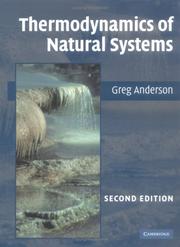
ISBN: 9780521612555 9780521847728 0521612551 0521847729 9780511840258 0511128037 9780511128035 051184025X 0511126689 9780511126680 0511199589 9780511199585 0511567871 9780511567872 0511127502 9780511127502 110715281X Year: 2005 Publisher: Cambridge: Cambridge university press,
Abstract | Keywords | Export | Availability | Bookmark
 Loading...
Loading...Choose an application
- Reference Manager
- EndNote
- RefWorks (Direct export to RefWorks)
Thermodynamics deals with energy levels and the transfer of energy between states of matter, and is therefore fundamental to all branches of science. This edition provides a relatively advanced treatment of the subject, specifically tailored for the interests of the Earth sciences. The first four chapters explain all necessary concepts, using a simple graphical approach. Throughout the rest of the book the author emphasizes the use of thermodynamics to construct mathematical simulations of real systems. This helps to make the many abstract concepts acceptable. Many computer programs are mentioned and used throughout the text, especially SUPCRT92, a widely used source of thermodynamic data. An associated website includes links to useful information sites and computer programs and problem sets. Building on the more elementary material in the first edition, this textbook will be ideal for advanced undergraduate and graduate students in geology, geochemistry, geophysics and environmental science.
Thermodynamics --- Geochemistry --- 550.4 --- 536.7 --- 504 --- Chemical composition of the earth --- Chemical geology --- Geological chemistry --- Geology, Chemical --- Chemistry --- Earth sciences --- Chemistry, Physical and theoretical --- Dynamics --- Mechanics --- Physics --- Heat --- Heat-engines --- Quantum theory --- Thermodynamics. Energetics --- Environment. Environmental science --- 504 Environment. Environmental science --- 536.7 Thermodynamics. Energetics --- 550.4 Geochemistry --- Thermodynamics - Textbooks --- Geochemistry - Textbooks
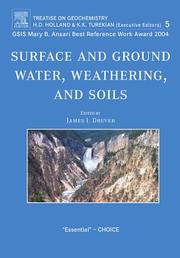
ISBN: 1281186473 9786611186470 0080547591 9780080547596 9781281186478 9780080447193 0080447198 Year: 2005 Publisher: Amsterdam Boston Elsevier
Abstract | Keywords | Export | Availability | Bookmark
 Loading...
Loading...Choose an application
- Reference Manager
- EndNote
- RefWorks (Direct export to RefWorks)
Volume 5 has several objectives. The first is to present an overview of the composition of surface and ground waters on the continents and the mechanisms that control the compositions. The second is to present summaries of the tools and methodologies used in modern studies of the geochemistry of surface and ground waters. The third is to present information on the role of weathering and soil formation in geochemical cycles: weathering affects the chemistry of the atmosphere through uptake of carbon dioxide and oxygen, and paleosols (preserved soils in the rock record) provide information on th
Geochemistry. --- Water chemistry. --- Groundwater. --- Weathering. --- Soil formation. --- Formation, Soil --- Pedogenesis --- Soil genesis --- Soils --- Weathering --- Erosion --- Ground water --- Subterranean water --- Underground water --- Water, Underground --- Water --- Hydrogeology --- Aquatic chemistry --- Chemical hydrology --- Hydrochemistry --- Hydrogeochemistry --- Natural water chemistry --- Geochemistry --- Hydrology --- Chemical composition of the earth --- Chemical geology --- Geological chemistry --- Geology, Chemical --- Chemistry --- Earth sciences --- Formation
Book
ISBN: 3540271414 Year: 2005 Publisher: Berlin, Heidelberg : Springer Berlin Heidelberg : Imprint: Springer,
Abstract | Keywords | Export | Availability | Bookmark
 Loading...
Loading...Choose an application
- Reference Manager
- EndNote
- RefWorks (Direct export to RefWorks)
This book is about the most complete work on the subject of clay minerals thus far conceived. Its scope is one of basics to general principles to use in real geologic situations. In principle any student, advanced student or casual researcher, should be able to ?nd an answer to almost any question posed. The breadth of knowledge presented is truly impressive. This presentation is especially important at present when the study of the most abundant minerals found near the Earth’s surface, clays, appears to ?nd disfavour with students and Universities. In fact we have never before needed such an encyclopaedic work to strengthen the discipline. At present when Earth sciences are slowing in popularity, the need for a precise and general education in the study of clay minerals is greater than ever before. Curiously the study of the environment, those materials found in the sphere of biological activity, is more relevant than ever. The natural progress of human activity through the age of science and then industrial activity up to the present stage of the post-industrial era has been marked by an increasing use of the Earth’s surface resources. The steady increase of the human population has called upon the natural resources of the surface in a non-linear manner. In the pre-industrial era agriculture and industry was concerned with the basic subsistence of populations. In good years there was enough to eat and in bad ones not enough.
Clay minerals. --- Clay. --- Aluminum silicates --- Binders (Materials) --- Sediments (Geology) --- Soils --- Minerals, Clay --- Rock-forming minerals --- Silicate minerals --- Geology, economic. --- Mineralogy. --- Geochemistry. --- Geology. --- Sedimentology. --- Agriculture. --- Economic Geology. --- Farming --- Husbandry --- Industrial arts --- Life sciences --- Food supply --- Land use, Rural --- Petrology --- Geognosy --- Geoscience --- Earth sciences --- Natural history --- Chemical composition of the earth --- Chemical geology --- Geological chemistry --- Geology, Chemical --- Chemistry --- Physical geology --- Crystallography --- Minerals --- Economic geology --- Mines and mineral resources --- Economic geology. --- Geology, Economic.
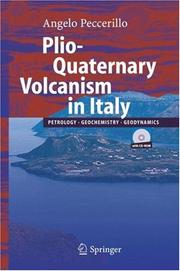
ISBN: 9783540258858 354025885X 9786610346905 1280346906 3540290923 Year: 2005 Publisher: Berlin ; New York : Springer,
Abstract | Keywords | Export | Availability | Bookmark
 Loading...
Loading...Choose an application
- Reference Manager
- EndNote
- RefWorks (Direct export to RefWorks)
Central-Southern Italy and the Tyrrhenian Sea are the sites of extensive Plio-Quaternary magmatic activity. The rock compositions include crustal anatectic granites and rhyolites, tholeiitic, calc-alkaline, shoshonitic volcanics, and potassic to ultrapotassic and Na-alkaline volcanics. This very wide compositional variation makes Italian magmatism one of the most complex petrological issues, the understanding of which is a challenge for modern petrology and geochemistry. This book summarises the petrological, geochemical and volcanological characteristics of Italian Plio-Quaternary volcanism, and discusses petrogenetic hypotheses and possible geodynamics settings. The book is written for petrologists and geochemists, but fundamental geochemical information is well presented and the use of excessive jargon is avoided, making the book readable to a wide audience of Earth scientists.
Volcanism --- Geology, Stratigraphic --- Volcanisme --- Stratigraphie --- Geology, Stratigraphic. --- Volcanism. --- Geology --- Earth & Environmental Sciences --- Dynamic & Structural Geology --- EPUB-LIV-FT LIVTERRE SPRINGER-B --- Pleiocene Epoch --- Pliocene Epoch --- Quaternary Period --- Volcanicity --- Vulcanism --- Earth sciences. --- Geochemistry. --- Geology. --- Mineralogy. --- Geophysics. --- Earth Sciences. --- Geophysics and Environmental Physics. --- Geophysics/Geodesy. --- Geodynamics --- Volcanology --- Physical geography. --- Physical geology --- Crystallography --- Minerals --- Geography --- Chemical composition of the earth --- Chemical geology --- Geological chemistry --- Geology, Chemical --- Chemistry --- Earth sciences --- Geognosy --- Geoscience --- Natural history --- Geological physics --- Terrestrial physics --- Physics

ISBN: 0080447201 9780080447209 0080448488 008044847X 0080447198 0080448496 0080446426 9780080446424 0080446434 9780080448480 9780080448473 9780080448497 9780080446431 9786611022921 0080525229 9786611022914 0080525350 9780080525358 1281022918 9781281022912 9780080525228 1281022926 9781281022929 0080443427 9780080443423 0080437516 9780080437514 Year: 2005 Volume: 1 Publisher: Amsterdam San Diego, CA Elsevier
Abstract | Keywords | Export | Availability | Bookmark
 Loading...
Loading...Choose an application
- Reference Manager
- EndNote
- RefWorks (Direct export to RefWorks)
Volume 1 provides a broad overview of the chemistry of the solar system. It includes chapters on the origin of the elements and solar system abundances, the solar nebula and planet formation, meteorite classification, the major types of meteorites, important processes in early solar system history, geochemistry of the terrestrial planets, the giant planets and their satellite, comets, and the formation and early differentiation of the Earth. This volume is intended to be the first reference work one would consult to learn about the chemistry of the solar system. Reprinted individual
Geochemistry. --- Geochemistry --- Meteorites --- Comets --- Planets --- Géochimie --- Météorites --- Comètes --- Planètes --- Earth (Planet) --- Terre --- Core. --- Mantle --- Manteau --- Diagenesis. --- Marine sediments. --- Sedimentary rocks. --- Garrels, Robert M. --- Comets. --- Meteorites. --- Planets. --- Rocks, Sedimentary --- Rocks --- Bottom deposits (Oceanography) --- Bottom sediments (Oceanography) --- Deep-sea deposits --- Deposits, Deep-sea --- Marine deposits --- Sediments, Marine --- Ocean bottom --- Sedimentation and deposition --- Submarine geology --- Sediments (Geology) --- Chemical composition of the earth --- Chemical geology --- Geological chemistry --- Geology, Chemical --- Chemistry --- Earth sciences --- Sedimentology --- Meteors --- Near-Earth objects --- 550.4 --- 550.4 Geochemistry
| Listing 1 - 10 of 16 | << page >> |
Sort by
|

 Search
Search Feedback
Feedback About UniCat
About UniCat  Help
Help News
News